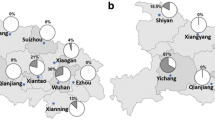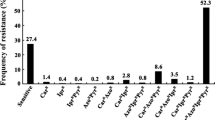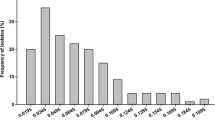Abstract
Tomato greenhouses in the Canary Islands, Spain, were surveyed to estimate frequencies of resistance to benzimidazoles, dicarboximides, anilinopyrimidines and N-phenylcarbamates in Botrytis cinerea. Resistance to carbendazim, iprodione, pyrimethanil and diethofencarb was found in 74.2, 86.4, 28.8 and 31.8 % of isolates, respectively. Benzimidazole- and anilinopyrimide-resistant isolates were highly resistant, showing EC50 values above 500 µg/ml carbendazim and a mean EC50 value of 28.42 µg/ml pyrimethanil, respectively. By contrast, a low level of resistance was observed among dicarboximide-resistant isolates (mean EC50 value of 1.81 µg/ml iprodione). Phenotypes with double resistance to carbendazim and iprodione, and triple resistance to carbendazim, iprodione and pyrimethanil were the most common, occurring in 36.4 and 28.8 % of isolates. The surveyed greenhouses had never been treated with fenhexamid and Signum™ (pre-packed mixture of boscalid and pyraclostrobin), and baseline sensitivities of B. cinerea isolates to these fungicides were determined. The EC50 values were within the range of 0.009–0.795 µg/ml fenhexamid and of 0.014–0.48 µg/ml Signum. In addition, available formulations based on elicitors of plant defense response and biocontrol agents were evaluated against B. cinerea in tomato plants under semi-controlled greenhouse conditions, the yeast Candida sake CPA-1 being able to reduce gray mold significantly when it was applied on petiole wounds and the plants were inoculated 24 h later. Likewise, C. sake was effective against B. cinerea in harvested tomato fruits, yeast-treated tomatoes showed a 70.66 and 30.31 % reduction in the diameters of decay lesions compared with controls after 10 days of storage at 20 and 9 °C, respectively.



Similar content being viewed by others

References
Amiri A, Heath SM, Peres NA (2013) Phenotypic characterization of multifungicide resistance in Botrytis cinerea isolates from strawberry fields in Florida. Plant Dis 97:393–401
Aziz A, Trotel-Aziz P, Dhuicq L, Jeandet P, Couderchet M, Vernet G (2006) Chitosan oligomers and copper sulfate induce grapevine defense reactions and resistance to gray mold and downy mildew. Phytopathology 96:1188–1194
Badawy MEI, Rabea EI (2009) Potential of the biopolymer chitosan with different molecular weights to control postharvest gray mold of tomato fruit. Postharverst Biol Technol 51:110–117
Bardas GA, Veloukas T, Koutita O, Karaoglanidis GS (2010) Multiple resistance of Botrytis cinerea from kiwifruit to SDHIs, QoIs and fungicides of other chemical groups. Pest Manag Sci 66:967–973
Baroffio CA, Siegfried W, Hilber UW (2003) Long-term monitoring for resistance of Botryotinia fuckeliana to anilinopyrimidine, phenylpyrrole, and hydroxyanilide fungicides in Switzerland. Plant Dis 87:662–666
Ben-Shalom N, Ardi R, Pinto R, Aki C, Fallik E (2003) Controlling gray mould caused by Botrytis cinerea in cucumber plants by means of chitosan. Crop Prot 22:285–290
Cañamas TP, Viñas I, Torres R, Usall J, Solsona C, Teixido N (2011) Field applications of improved formulations of Candida sake CPA-1 for control of Botrytis cinerea in grapes. Biol Control 56:150–158
Dal Bello G, Monaco G, Rollan MC, Lampugnani G, Arteta N, Abramoff C, Ronco L, Stocco M (2008) Biocontrol of postharvest grey mould on tomato by yeasts. Phytopathology 156:257–263
Dik AJ, Elad Y (1999) Comparison of antagonists of Botrytis cinerea in greenhouse-grown cucumber and tomato under different climatic conditions. Eur J Plant Pathol 105:123–137
Edwards SG, Seddon B (2001) Selective media for the specific isolation and enumeration of Botrytis cinerea conidia. Lett Appl Microbiol 32:63–66
Elad Y, Stewart A (2004) Microbial control of Botrytis spp. In: Elad Y, Williamson B, Tudzynski P, Delen N (eds) Botrytis: biology, pathology and control. Kluwer Academic Publishers, Dordrecht, pp 223–241
Elad Y, Yunis H, Katan T (1992) Multiple fungicide resistance to benzimidazoles, dicarboximides and diethofencarb in field isolates of Botrytis cinerea in Israel. Plant Pathol 41:41–46
Fernández-Ortuño D, Chen F, Schnabel G (2012) Resistance to pyraclostrobin and boscalid in Botrytis cinerea isolates from strawberry fields in the Carolinas. Plant Dis 96:1198–1203
Fillinger S, Leroux P, Auclair C, Barreau C, Al Hajj C, Debieu D (2008) Genetic analysis of fenhexamid-resistant field isolates of the phytopathogenic fungus Botrytis cinerea. Antimicrob Agents Chemother 52:3933–3940
Kalogiannis S, Tjamos SE, Stergiou A, Antoniou PP, Ziogas BN, Tjamos EC (2006) Selection and evaluation of phyllosphere yeast as biocontrol agents against grey mould of tomato. Eur J Plant Pathol 116:69–76
Katan T, Elad Y, Yuris H (1989) Resistance to diethofencarb (NPC) in benomyl-resistant field isolates of Botrytis cinerea. Plant Pathol 38:86–92
Kim YK, Xiao CL (2010) Resistance to pyraclostrobin and boscalid in populations of Botrytis cinerea from stored apples in Washington State. Plant Dis 94:604–612
Korolev N, Mamiev M, Zahavi T, Elad Y (2011) Screening of Botrytis cinerea isolates from vineyards in Israel for resistance to fungicides. Eur J Plant Pathol 129:591–608
Latorre BA, Torres R (2012) Prevalence of isolates of Botrytis cinerea resistant to multiple fungicides in chilean vineyards. Crop Prot 40:49–52
Lee JP, Lee S-W, Kim CS, Son JH, Lee KY (2006) Evaluation of formulations of Bacillus licheniformis for the biological control of tomato gray mold caused by Botrytis cinerea. Biol Control 37:329–337
Leroch M, Kretschmer M, Hahn M (2011) Fungicide resistance phenotypes of Botrytis cinerea isolates from commercial vineyards in south west Germany. J Phytopathol 159:63–65
Leroux P (2004) Chemical control of Botrytis and its resistance to chemical fungicides. In: Elad Y, Williamson B, Tudzynski P, Delen N (eds) Botrytis: biology, pathology and control. Kluwer Academic Publishers, Dordrecht, pp 195–222
Mari M, Guizzardi M, Brunelli M, Folchi A (1996) Postharvest biological control of grey mould (Botrytis cinerea Pers.: Fr.) on fresh-market tomatoes with Bacillus amyloliquefaciens. Crop Prot 8:699–705
Moyano C, Gómez V, Melgarejo P (2004) Resistance to pyrimethanil and other fungicides in Botrytis cinerea populations collected on vegetable crops in Spain. J Phytopathol 152:484–490
Myresiotis CK, Karaoglanidis GS, Tzavella-Klonari K (2007) Resistance of Botrytis cinerea isolates from vegetable crops to anilinopyrimidine, phenylpyrrole, hydroxyanilide, benzimidazole, and dicarboximide fungicides. Plant Dis 91:407–413
O´Neill TM, Niv A, Elad Y, Shtienberg D (1996) Biological control of Botrytis cinerea on tomato stem wounds with Trichoderma harzianum. Eur J Plant Pathol 102:635–643
O’Neill TM, Shtienberg D, Elad Y (1997) Effect of some host and microclimate factors on infection of tomato stems by Botrytis cinerea. Plant Dis 81:36–40
Raposo R, Delcan J, Gomez V, Melgarejo P (1996) Distribution and fitness of Botrytis cinerea with multiple fungicide resistance in Spanish greenhouses. Plant Pathol 45:497–505
Rosslenbroich HJ, Stuebler D (2000) Botrytis cinerea—history of chemical control and novel fungicides for its management. Crop Prot 19:557–561
Sadfi-Zouaoui N, Hannachi I, Andurand D, Essghaier B, Boudabous A, Nicot P (2008) Biological control of Botrytis cinerea on stem wounds with moderately halophilic bacteria. World J Microbiol Biotechnol 24:2871–2877
Saligkarias ID, Gravanis FT, Epton HAS (2002) Biological control of Botrytis cinerea on tomato plants by the use of epiphytic yeast Candida guilliermondii stratins 101 and US 7 and Candida oleophila strain I-182: I. in vivo studies. Biol Control 25:143–150
Sun HY, Wang HC, Chen Y, Li HX, Chen CJ, Zhou MG (2010) Multiple resistance of Botrytis cinerea from vegetable crops to carbendazim, diethofencarb, procymidone, and pyrimethanil in China. Plant Dis 94:551–556
Viñas I, Usall J, Teixido N, Sanchis V (1998) Biological control of major postharvest on apple with Candida sake. Int J Food Microbiol 40:9–16
Wang F, Feng G, Chen K (2009) Defense responses of harvested tomato fruit to burdock fructooligosaccharide, a novel potential elicitor. Postharvest Biol Technol 52:110–116
Weber RWS (2011) Resistance of Botrytis cinerea to multiple fungicides in northern German small-fruit production. Plant Dis 95:1263–1269
Williamson B, Tudzynski B, Tudzynski P, Van Kan JAL (2007) Botrytis cinerea: the cause of grey mould disease. Mol Plant Pathol 8:561–580
Yourman LF, Jeffers SN (1999) Resistance to benzimidazole and dicarboximide fungicides in greenhouse isolates of Botrytis cinerea. Plant Dis 83:569–575
Zhang CQ, Hu JL, Wei FL, Zhu GN (2009) Evolution of resistance to different classes of fungicides in Botrytis cinerea from greenhouse vegetables in eastern China. Phytoparasitica 37:351–359
Zhang C, Chen K, Wang G (2013) Combination of the biocontrol yeast Crytococcus laurentii with UV-C treatment for control of postharvest diseases of tomato fruit. Biocontrol 58:269–281
Zong Y, Liu J, Li B, Qin G, Tian S (2010) Effects of yeast antagonists in combination with hot water treatment on postharvest diseases of tomato fruit. Biol Control 54:316–321
Acknowledgments
This research was supported by Project RTA 2006-00184 (Programa Nacional de Recursos y Tecnologías Agroalimentarias, Ministerio de Educación y Ciencia, Spain). The authors thank the Cooperativa Agrícola Coagisora for technical support in sampling tomato greenhouses, and to Capa Ecosystems (Spain) and Sipcam Inagra (Spain) for providing the products assayed.
Author information
Authors and Affiliations
Corresponding author
Rights and permissions
About this article
Cite this article
Rodríguez, A., Acosta, A. & Rodríguez, C. Fungicide resistance of Botrytis cinerea in tomato greenhouses in the Canary Islands and effectiveness of non-chemical treatments against gray mold. World J Microbiol Biotechnol 30, 2397–2406 (2014). https://doi.org/10.1007/s11274-014-1665-5
Received:
Accepted:
Published:
Issue Date:
DOI: https://doi.org/10.1007/s11274-014-1665-5



